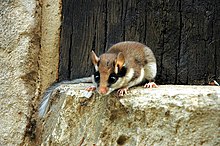Garden dormouse
| Garden dormouse | |
|---|---|
 |
|
| Scientific classification | |
| Kingdom: | Animalia |
| Phylum: | Chordata |
| Class: | Mammalia |
| Order: | Rodentia |
| Suborder: | Sciuromorpha |
| Family: | Gliridae |
| Genus: | Eliomys |
| Species: | E. quercinus |
| Binomial name | |
|
Eliomys quercinus (Linnaeus, 1766) |
|
 |
|
| Geographic range | |
The garden dormouse (Eliomys quercinus) is a rodent in the dormouse family.
Garden dormice are typically 10 to 15 cm (3.9 to 5.9 in) in length, with the tail adding 8 to 14.5 cm (3.1 to 5.7 in). They weigh 60 to 140 g (2.1 to 4.9 oz). The coat is gray or brown, with a white underside. The garden dormouse can be recognized by black eye markings, relatively large ears, short hair, and a white tassel at the end of the tail.
In spite of its name, the garden dormouse's main habitat is the forest, though it can also be found in fruit-growing regions. It is particularly common in southern Europe, but its range extends into the north. Garden dormice are often found in the Alps, the Bavarian Forest, and the Ore Mountains.
The species is also present in northern Germany, but that population is apparently not capable of large-scale reproduction. Nearby, in the Netherlands, it is nearly extinct: in 2007, researchers reported finding only nine animals in two woods in the province of Limburg, where it used to be common. They suggested this is a result of the landscape becoming increasingly monotonous, and due to climate change, which they said interrupts hibernation.
Garden dormice are primarily nocturnal, sleeping in spherical nests in trees during the day. At night, they look for food, mainly eating larger insects, such as grasshoppers and beetles, and snails, eggs, young nestlings, small rodents, and spiders, as well as berries, fruit, and nuts, such as acorns and beechnuts. While omnivorous, the diet of dormice contains slightly more animal protein than vegetation.
...
Wikipedia

